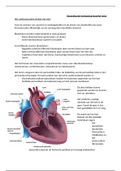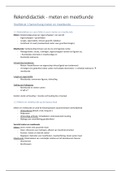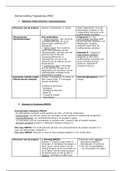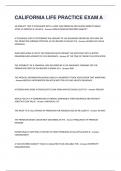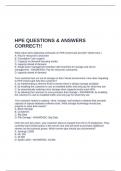OVERVIEW
Claimant identify specific property in hand of Dcommon law ‘following’ return specific property
When claimant’s property has passed into hands of D but substituted for another item of
property which claimant has never previously had an proprietary rights, the claimant must ‘trace’
their original property into the substitute property, if substitute property has not been mixed
with another property, then pursue COMMON LAW TRACING against that substitute property
If original property/substitute mixed with other property= EQUITABLE TRACING as common law
tracing cannot penetrate mixtures equitable requires claimant had some pre-existing
proprietary right in that property, mixture of property divided proportionately between
contributors to mixture in all cases except money mixed in bank accounts
Issue where money passed through bank accounts distinction in equitable tracing where
trustee mixes trust property with own property, and situations which innocent people’s money is
mixed courts will go against a trustee who mixes trust property with own
Several different approaches when innocent person’s money is mixed leading approach is ‘first
in, first out’ which assumes first money into account was first money to be spent on first property
acquires then ‘second in, second out’; courts also prefer approach which divides property
acquired from a mixed account into proportionate shares among contributors to that mixture
(used when first in fist out approach reaches irrational outcome)
There can be no tracing action for property which has ceased to exist
Remedies available in tracing: constructive trust, equitable charge, a lien, or subrogation
claimant needs to show which remedy is appropriate in any situation where a constructive trust
will establish beneficial ownership of the property, charge secures a payment of money to
claimant, a lien takes possession of property to secure payment of money and subrogation
revives a debt which has been discharged using claimant’s property
Defences available to tracing claims: change of position, bona fide purchase of property for value,
estoppel by representation and passion on if successful tracing action will fail
NATURE of tracing claim
Allows owner of property to recover property where it is taken from them involuntarily or to
recover substitute property if original property cannot be identified
Trace original property into a substitute property acquired using their original property e.g. stole
money then bought house, impose property rights over house; but if money was mixed with an
innocent person’s money and brought several things see which property to claim
Tracing operates 3 levels: (1)owner recover original property from D, (2) owner recover both
original property + profits from Ds use of property, (3) owner not be able to recover original
property as mixed with other property, or cannot be found, or person acquired good title e.g. by
good faith so seeks property rights in other property acquired by original property (assert title in
substitute property= ‘traceable proceeds’ original property traced into substitute property)
Easier to seek title in original property previously owned but a bit harder for substitute property
e.g. car stolen for original property just prove number plate, if car sold seek recover sale
proceeds need trace property rights from car into cash which D received from sale of car
E.g. Timothy, a trustee, removes a painting from trust fund, transfers it to another person Anne, his
accomplice then consider different scenarios
(1) Identify original property beneficiaries proceed against Timothy for breach of truth
(2) Substitute property transferred painting to Anne but Anne sold to third person but if
Timothy has no money to make good of loss, and suppose Anne did not have paining in possession
at time of claim and sold to a bona fide purchaser for value without notice of breach beneficiaries
1
, cannot recover original painting as bona fide purchaser has complete defence suppose Anna still
has money it is more complex as it is not the original property then common law claim as substitute
(traces as property in Anne’s hands is different property as a substitute to painting)
Common law tracing claim allows claimant to establish rights in property which original property
+ any substitute property kept distinct from all other property e.g. money kept in bank account
If mixed with other property then equitable tracing as common law not extend to mixtures
(3) Mixtures of property suppose painting sold to Anne, Timothy no money, now unobtainable but
Anne still has proceeds from sale of painting , but put money in bank account with other money
now has to be equitable tracing claim BUT for EQUITABLE need ESTABLISH: claimant must have
equitable interest in original property before the action
Comparison with personal liability to account
Tracing claims operate with other principles e.g. liable for breach of trust, Anne liable for
unconscionable receipt and possibly dishonest assistance but personal liability to account is a
personal claim, so if Anne and Timothy go into insolvency, no purpose as not proprietary
But tracing claims focus is on establishing proprietary claim to specific property, where property
increases in value proprietary claim allows claim any profit from that property
Distinction between following, common law tracing and equitable tracing
Following + tracing both locate assets claimants assert ownership in but following in same asset
as it moved from hand to hand, tracing is identifying new asset as the substitute for the old
Following requires specific property is followed + identified by its original common law owner
Tracing identifies property or value which substitutes for original property
Common law only allows following original property that has been taken from original owner but
extended to ‘clean substitutions’ where original is substituted but kept distinct from other
property e.g. car sold, proceeds kept in new bank account not mixed with other money clean
Equitable wider entitles claimant rights in substitute for original + in mixtures property is passed
Tracing is process – not remedy
A process, not itself a remedy trace a right in an original property into subsequent property or
value identify property which was substituted for original property
So need to trace into appropriate property then identify best remedy against that property
But if claimant cannot show any property derives from original, then no right to any remedy
Court can order direct transfer to original owner or resulting/constructive trust or subject to a
charge, remedy is separate issue from whether can establish a tracing claim against that property
Boscawen v Bajwa [1995]: ‘tracing is neither a claim nor remedy but a process which plaintiff
traces what has happened to their property, identifies persons who have handled or received it,
and justifies claim that money handled or received can be regarded as representing his property,
this is by a claimed based on retention by them of a beneficial interest in property D handled’
Common law remedies may be available for common law tracing
COMMON LAW TRACING
Permits claimant to identify property belongs at common law to claimant need to show
property claimed is the very property to be restored + it is not mixed with other property
Lipkin Gorman v Karpnale [1991]*: Norman, partner of a solicitor’s firm took money from firm’s
client account to gamble, casino held some money separately in an account for partner, firm
sought recover money paid to casino with common law tracing held can as identified as having
come from client account + not mixed provided not mixed common law tracing possible
2


